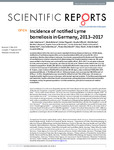Incidence of notified Lyme borreliosis in Germany, 2013–2017
Enkelmann, Julia
Böhmer, Merle
Fingerle, Volker
Siffczyk, Claudia
Werber, Dirk
Littmann, Martina
Merbecks, Sophie-Susann
Helmeke, Carina
Schroeder, Sabine
Hell, Stefan
Schlotthauer, Uwe
Burckhardt, Florian
Stark, Klaus
Schielke, Anika
Wilking, Hendrik
Lyme borreliosis (LB) is the most commonly reported tick-borne disease in Germany. In 9/16 states, notification of erythema migrans (EM), acute neuroborreliosis (NB) and Lyme arthritis (LA) is mandatory. We describe incidence measures, time trends, geographical distribution and frequencies of manifestations to better understand LB epidemiology and target prevention measures. We used cases notified in the 9 states and confirmed by local health offices, 2013–2017, to calculate incidences by time, place and person. Altogether, we observed 56,446 cases. Disease onset peaked yearly in July. Incidence ranged from 26/100,000 (2015) to 41/100,000 (2013) with mean annual incidences 2013–2017 on district level between 0.5/100,000 and 138/100,000. Median age was 54 years with peaks in boys (5–9 years, mean incidence 36/100,000) and women (50–69 years, mean incidence 57/100,000). 95% experienced EM only, 2.7% NB and 2.1% LA. 54% were female, but more men had NB (56%) and LA (53%, p < 0.001). Hospitalisation was recorded for 10% of LA and 71% of NB cases. LB remains an important public health concern in Germany with marked regional variation. To facilitate early diagnosis and treatment, health authorities should raise awareness among physicians and promote prevention strategies among the general population: tick-bite-protection, prompt tick removal and medical consultation.
Dateien zu dieser Publikation

